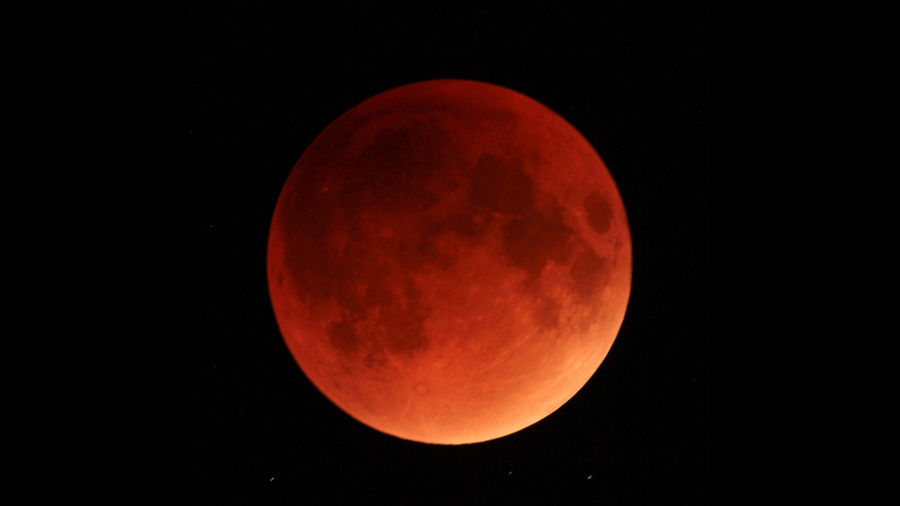On the night of September 7, the full Blood Moon 2025 will drift into Earth’s shadow, triggering a rare total lunar eclipse. As it does, sunlight bending through Earth’s atmosphere will paint the Moon red — creating a glowing Blood Moon.
This mesmerizing event will last 86 minutes of totality, making it one of the longest and most visible lunar eclipses of the decade.
🌑 What Is a Blood Moon?
A Blood Moon happens during a total lunar eclipse, when Earth passes directly between the Sun and the Moon. Sunlight is filtered through Earth’s atmosphere — blue light scatters away, and only the red wavelengths reach the Moon. That’s why it glows in deep red or copper tones.

📅 Blood Moon 2025 – Date, Time & Where to Watch
🗓️ When?
- 7 September 2025 (local time)
- In some regions, visible between night of Sept 7 → early Sept 8
🌍 Where?
- Full Totality: Europe, Africa, Asia, Australia
- Partial Visibility: Western North America, Eastern South America
⏰ Examples of Local Time (Totality Window):
- 🌆 Mumbai: 11:00 pm – 12:22 am (Sept 7 → 8)
- 🕌 Cairo: 8:30 pm – 9:52 pm (Sept 7)
- 🦘 Perth: 1:30 am – 2:52 am (Sept 8)
- 🌊 Cape Town: 7:30 pm – 8:52 pm (Sept 7)
💡 Pro Tip: Choose a spot with open sky + minimal light pollution.
Even with the naked eye, the Moon will glow beautifully — but binoculars reveal stunning surface details.
🔭 The Science Behind the Spectacle
The September 2025 eclipse is scientifically significant because:
- Atmospheric science: The red glow tells scientists about Earth’s atmospheric dust and particles.
- Lunar reflectivity: The eclipse changes how much light the Moon reflects — data that helps in planetary studies.
- Orbital mechanics: This eclipse has an umbral magnitude of ~1.36, which explains why it lasts so long (~82 minutes).
Just like how the upcoming Solar Storm 2025 has scientists alert, events like this Blood Moon also offer insights into how cosmic events interact with our planet.
🌕 Blood Moon vs. Supermoon: What’s the Real Difference?
People often confuse a Blood Moon with a Supermoon, but these two stunning sky events are completely different — and each has its own science.
🔴 Blood Moon: The Fiery Red Eclipse
A Blood Moon happens during a total lunar eclipse. When Earth comes directly between the Sun and the Moon, sunlight bends through Earth’s atmosphere and scatters. Blue light gets filtered out, leaving only deep red and orange hues to paint the Moon’s surface.
- Symbol of shadow and light play in our solar system.
- Color intensity depends on Earth’s atmosphere (dust, ash, pollution).
- Example: The Blood Moon 2025 will last nearly 82 minutes, making it a rare celestial spectacle.
👉 You can read more about how Earth’s shadow shapes lunar events in our Astrophysics section.
🌕 Supermoon: The Giant Bright Moon
A Supermoon is not an eclipse at all — it’s about distance. When the Moon’s orbit brings it closest to Earth (perigee) and it’s also a full moon, it appears up to 14% larger and 30% brighter than a normal full moon.
- Symbol of size and brightness rather than color.
- Best viewed when it rises near the horizon — making it look dramatically huge.
- Example: The Blood SuperMoon 2025 will combine both phenomena: a total eclipse and a perigee full moon.

🧠 Did You Know?
During the last Blood SuperMoon, data showed increased lunar tidal forces affecting ocean tides and possibly even influencing tectonic movement.
Some even believe these rare alignments could link to gravitational wave behavior—much like the controversial theories that emerged during the NASA parallel universe rumors.
While those ideas may stretch scientific consensus, they reflect humanity’s deep curiosity about the cosmos.
📸 How to Photograph the Blood Moon
Want to capture this once-in-a-decade event?
- Use a DSLR camera with a tripod
- Set to manual mode
- Use a shutter speed of 1/125 or slower
- Adjust ISO and aperture for clarity
- Try time-lapse for eclipse phases
🌍 Why It Matters for All 7 Billion of Us
In a world of noise, conflict, and constant distraction, a moment of cosmic alignment can reconnect us to something greater.
The Blood Moon 2025 invites us to look up, reflect, and remember that we’re all part of one delicate, beautiful universe.
🌠 Whether you’re a scientist, a stargazer, or a dreamer—this rare event is a reminder that magic still exists in the sky above.
📌 Final Thought
The Blood moon 2025 on September 7 promises to be one of the most spectacular sky events of the decade. As the Moon glows red and looms larger than usual, it’s a rare moment to pause, look up, and reconnect with the cosmos. Whether you’re a space enthusiast or a casual skywatcher, this is your chance to witness nature’s celestial masterpiece.
So mark your calendar, grab your camera, and step outside — the universe is putting on a show you won’t want to miss.




